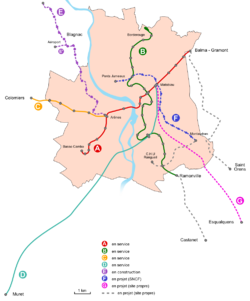Toulouse Metro
 |
|||
| Overview | |||
|---|---|---|---|
| Native name | Métro de Toulouse | ||
| Locale | Toulouse, Midi-Pyrénées, France | ||
| Transit type | Rapid transit | ||
| Number of lines | 3 | ||
| Number of stations | 40 | ||
| Daily ridership | 281,000 (2011) | ||
| Website | Tisséo | ||
| Operation | |||
| Began operation | June 1993 | ||
| Operator(s) | Tisséo | ||
| Technical | |||
| System length | 28.2 km (17.5 mi) | ||
| Track gauge | 1,435 mm (4 ft 8 1⁄2 in) standard gauge | ||
| Electrification | 750 V DC third rail | ||
|
|||
The Toulouse metro (French: Métro de Toulouse) serves the city of Toulouse, France, and some of the surrounding area. The city's public transport system was initially managed by Société d'économie mixte des voyageurs de l'agglomération toulousaine (SEMVAT), which was a company that was 80% owned by local government bodies and 20% privately owned. It has been managed by Tisséo, under the authority of the Syndicat Mixte des Transports en Commun (an authority established by various local government bodies) since 2003.
The Toulouse metro consists of two primarily underground metro lines, Lines A and B, that together serve 37 stations (38 stations, if the single transfer station between Lines A and B is counted twice), and comprise 28.2 kilometres (17.5 mi) of route. The metro itself is supplemented by Lines C and D, which are suburban rail lines running to the west of the city and to Muret respectively, and by lines T1 (old line E) and T2 which are a tramway to Blagnac's suburbs.
The Toulouse metro is currently composed of two lines:
Line A currently comprises 18 stations on a 12.5 kilometres (7.8 mi) route. The original section of Line A opened in June 1993; an extension from Jolimont to Balma-Gramont opened in 2002. It extends from the shopping centre of Balma through Toulouse with stations at Marengo (connecting with the main SNCF railway station), Capitole, Place Esquirol and University of Mirail. After its final station, Basso-Cambo, is a carriage shed-workshop, which provides storage, maintenance and tests of the rolling stock for the whole of network. The Central Control Centre is also located at the garage-workshop.
Operating hours: 05:15 to midnight (Sunday to Thursday), and until 03:00 (Friday and Saturday).
In order to reduce costs, five of the 18 stations have short platforms. Long platforms are needed to use four-carriage trains instead of two in order to double the capacity of the line. As a result, 13 years after its opening the line is saturated - peak hour lasts longer and longer, and the opening of Line B (2007), Line E (2009) and various exclusive bus lanes will bring additional traffic flows on to Line A and suggests that the use of Line A will become increasingly uncomfortable. Fortunately it is intended to lengthen the platforms of all the short stations, but this will not occur before 2012 at best.
...
Wikipedia

